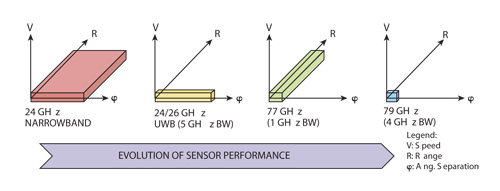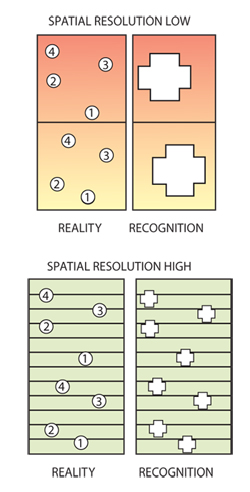The 79 GHz band (77 to 81 GHz) was identified in Europe as the most suitable frequency band for long-term and permanent deployment of high resolution automotive radars due to its benefits. This article highlights the applications and benefits of 79 GHz, motivating a harmonized regulation for the 77 to 81 GHz band as a stable, permanent and globally harmonized frequency band for high resolution automotive radar equipment; and illustrates the status of allocation of the 77 to 81 GHz band in the key countries around the world and the current on-going initiatives for regulation.
Automotive Short Range Radar Applications
The last 10 years have shown a big revolution regarding automotive radar applications. The automotive industry’s long-term goal is accident-free driving that can be achieved due to 360° surround vision or semi-autonomous/fully autonomous driving. As a matter of fact, automotive radars are one of the main tools to achieve these visions. As a consequence, evolution of automotive radar applications followed two ways: from only front side looking to rear/side looking up to 360° vision and from comfort functions that only give indications to the driver (e.g., sound alert or visual warning) to safety functions that will automatically control the vehicle (i.e., act on the brakes or the steering).

To support this evolution, the 79 GHz band is an ideal choice for every radar supplier for next-generation sensors that need to meet high-level requirements. A wide range of applications will benefit from the use of the 79 GHz band (see Table 1): the adaptive cruise control (ACC) whose principle is the acceleration/deceleration of the vehicle to keep a constant distance to the vehicle in front or stop behind a stopped vehicle and follow the vehicle when it drives on (requires driver input); the collision warning system (CWS) which provides an acoustic and/or optical warning to the driver and may prepare the braking system by building up pressure and increases the braking force if the driver does not generate the necessary deceleration to avoid the collision; the collision mitigation system (CMS) which provides optical and acoustic warning and prepare the braking system by building up pressure including eventually autonomous braking if the driver does not generate the necessary deceleration to avoid the collision; the vulnerable road user detection (VUD) which supports the detection of vulnerable road users (cyclists or pedestrians) in front (potentially also on the side of the vehicle) in order to enable warning or assist brake functions; the blind spot monitoring (BSD) function which observes adjacent lane in the area next to the host vehicle, in order to avoid lane change collisions with traffic at approximately the same velocity autonomous steering controllability might be an evolution of this function; the lane change assistance (LCA) radar which observes the adjacent lane in the area behind the host vehicle, in order to avoid lane change collisions with traffic approaching with a higher velocity from the rear; and the rear cross traffic alert (RCTA) sensors observing the area behind the host vehicle, in order to avoid collisions with crossing traffic when reversing, e.g., in a parking lot.

Figure 1 Evolution of sensor performance for short range applications.
Benefits of 79 GHz Band
Several studies, for instance those carried out in the activity of the EU founded project MOSARIM (https://assrv1.haw-aw.de/), have shown that higher frequency radar systems tend to be more reliable, with better performance and accuracy (see Figure 1). There are different advantages in the use of 79 GHz band. For instance, multiple objects cannot be distinguished if they appear in the same range gate and are fused to one virtual object. The possibility of having a large bandwidth of 4 GHz, available at 79 GHz, allows a better target discrimination capability. Spatial resolution capability is directly linked to the available bandwidth. The higher the used bandwidth, the better the spatial resolution will be, as shown in Figure 2. For safety-critical applications, an exact location determination is very important to reduce unjustified system responses or false alarms.

Figure 2 Comparison of spatial resolution of low and high bandwidth sensors.
Radar devices are much smaller at 79 GHz compared to 24 GHz: HF-circuit structures and antenna sizes directly depend on the used wavelength. The higher the operational frequency is, the smaller the total size of the radar device. The relationship is of linear character and results, when comparing 24 GHz with 79 GHz, in a ratio-factor of 3. Common usage of one technology concept for all applications (currently automotive radar applications use different frequency ranges for the different applications); by using a common 76 to 81 GHz technology platform a holistic and flexible system concept can be established. This results in advantages regarding system development and multi-functional use of individual sensors. Mutual interference risk is low due to the smaller emission power: since compared with the 77 GHz long range radar (and also the 24 GHz narrowband devices) the average emission power of 79 GHz is three orders of magnitude lower, the interference distance is more than one order of magnitude lower, resulting in more robustness and interference margin.
Research and Development Projects
Various projects have been initiated since the European Decision in 2004 to open the 79 GHz band for automotive SRR. This includes, for instance, the above mentioned EU-founded project MOSARIM whose main objectives are the investigation in mutual vehicular radar interference and the definition and elaboration of effective counter-measures and mitigation techniques focusing on automotive radar operation frequencies from 24 to 79 GHz. In addition, the Radar on Chips for Cars (RoCC) project, involving Daimler, BMW, Bosch, Infineon and Continental (financed by the German government), targets to further advance silicon-based radar technology in the 76 to 81 GHz band with special emphasis on SRR with the final goal to bring down the cost of 79 GHz automotive radar sensors significantly and make them cost-competitive.
In France, research and development work has also been undertaken for 79 GHz UWB SRR technology mainly within the framework of three projects (RADAR ACC, ARPOD and RASSUR 79), financed by the general delegation of the French equipment (DGE), in complement to internal PSA Peugeot Citroën Automobile works. The RADAR ACC project is focused in developing a sensor capable of answering at the same time the specifications of the ACC, the pre-crash and the collision mitigation with the 76/79 GHz UWB technology. The ARPOD project focused in answering to the peripheral performances of the vehicle (example LCA, BSD, side FCW, pre-crash) by mean of the development of sensors with the 76/79 GHz technology and materials bumper adapted; the RASSUR79 project focused on the development of low cost high resolution radars operating within 77 to 81 GHz, for applications such as ACC and AEBS.
79 GHz Frequency Allocation
Taking into account the benefits of the 79 GHz band and the current status of the regulation in Europe (defined by the European Commission in 2004) and in others countries in the world (Russia, Singapore, etc.), the EU-founded project 79 GHz (www.79ghz.eu), supported by different companies, is currently operating to establish and speed up the worldwide harmonized frequency allocation for vehicular radars in that frequency range and to avoid jeopardizing the implementation of the previous described high performance radar applications.
At the beginning of the project, the 79 GHz radar equipment was only authorized in the 27 EC member states, in most of the further 21 CEPT countries, in Singapore and Australia. In all other countries, the operation of 79 GHz radar devices was not possible due to the lack of any regulatory framework for this frequency band.
Various actions have been taken by the 79 GHz project partners. In the USA, there have been extensive discussion and several meetings with Federal Communications Commission (FCC) and tests have been carried out to evaluate the interference with radio astronomy sites equipped with radar operating at the same frequencies. A petition to adopt and release the 77 to 81 GHz band is expected by midyear 2013. Canada’s decision regarding 79 GHz partially follows the U.S. FCC rules due to the cross-border situation and direct neighborhood to the USA.
In Japan, the 79 GHz band is now regulated while the 500 MHz allocation in frequency band 77 GHz is still in discussion. A positive outcome is expected from countries like Hong Kong and Korea, where the Korea’s National Radio Research Agency (RRA) is preparing to amend the legislation procedure to accept 79 GHz. 79 GHz project had a successful meeting with Thailand’s National Broadcasting and Telecommunication Commission (NBTC): the Thai Automotive Industry Association (TAIA) is expected to submit a petition to NBTC with requests to regulate 79 GHz.
Several Gulf States are preparing for the introduction and in Brazil, where the regulation process started the process in 2012, there are on-going activities between ANATEL (the frequency authority in Brazil) and AEA (Associação Brasileira de Engenharia Automotiva) with the aim to analyze and review the European and U.S. studies for 79 GHz. In Argentina, CSA79GHz project is in contact with CNC (Comisión Nacional de Comunicaciones) and SECOM (Secretariat of Communications). In Chile, SUBTEL (Subsecretaría de Telecomunicaciones) has now regulated the 79 GHz band. China and India have currently no regulation for 79 GHz but initiatives are currently on-going promoted by the CSA 79 GHz project.
In the context of the 79 GHz project, the CLEPA (the European association of automotive suppliers) and OICA (the International organization of motor vehicle manufacturers) organizations decided (October 2012) to create a joint task group called GARREG, the International Automotive Radio Regulations Expert Group.
Radio communication systems are more and more used by the automotive industry to equip cars. Radar, keyless entry, tire pressure monitoring system (TPMS) and car-to-car communications are among all of these systems. Global harmonization is the key for car manufacturers to install such systems in the car and there is a crucial need for a global automotive group with legitimacy to support and drive the automotive frequency regulations on a worldwide level, a group that must be at the same level as other organizations (e.g., ITU-R) or interest groups (e.g., CRAF).
The creation of the GARREG group is in line with the above mentioned objectives and it will support the promotion of the interests of the Worldwide Automotive Industry regarding the Regulatory issues on radio based automotive systems and components, the use of the appropriate harmonized frequency bands for radio based automotive application within the existing and future regulatory environment and, finally, the maintenance of appropriate existing frequency bands.
This article is based on contributions from the activities of the partners of the European Commission founded 79 GHz project: Robert Bosch GmbH, TRW, ERTICO — ITS Europe, Continental and Renault.
